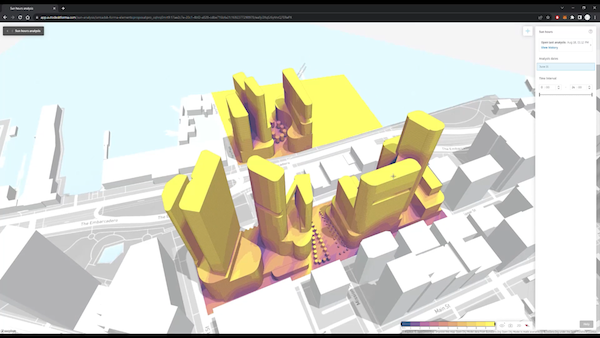
Image source: Czintos Ödön/stock.adobe.com.
As artificial intelligence (AI) garners growing worldwide attention, infrastructure professionals are experiencing firsthand how AI can provide tangible benefits. In addition to providing numerous consumer applications, AI is impacting how infrastructure assets are designed, built, and operated, with additional opportunities on the horizon.
In a sector hindered by resource constraints and historic backlogs, AI can help infrastructure professionals become more productive. By augmenting, complementing, and enhancing the work of infrastructure professionals, AI can help professionals accomplish more, without replacing workers.
More Efficient Inspections
As an example, engineers have used computer vision and AI techniques to identify, analyze, and detect defects in roads, bridges, dams, rail networks, and other facilities. On the Robert Street Bridge in St. Paul, MN, Collins Engineers used iTwin Capture from Bentley Systems to process over 57,000 drone-captured images. Using iTwin Experience, the team then created a detailed digital twin of the bridge, enabling engineers to use an AI-aided process to pre-inspect the bridge, study its condition, and document defects before going to the site.
By using computer vision and AI to pre-inspect the eight-span, reinforced concrete arch bridge, Collins Engineers was able to reduce time spent on site by at least 20%, yielding over USD 90,000 in savings. Information shared via the digital twin could result in up to USD 15 million in savings for the Minnesota Department of Transportation (MnDOT) and a 10% reduction in materials used during the construction process.
AI capabilities were used to automate detection of cracks and other defects on the historic Robert Street Bridge in St. Paul, MN. Image source: Collins Engineers, Inc. Click image to enlarge.
AI has also been used to perform predictive maintenance for facilities such as dams and bridges. Using historical data and IoT sensor data, along with Bentley’s dam monitoring solutions and bridge monitoring solutions, engineers can monitor the behavior of structures and plan future maintenance activities.
Extracting Dark Data
In another case, AI has been used to extract and catalog roadway features from CAD drawings. Phocaz, Inc., a software development and technology firm, helped the Georgia Department of Transportation (GDOT) collect data from CAD files representing 80,000 lane-miles of roadways, then automate data extraction and entry into GDOT’s enterprise geographic information system (GIS).
The CAD Level Integration Process (CLIP) features AI-powered algorithms, a digital twin model, and a virtual robot car that “drives the digital lanes” to extract features. The system examines the drawing by progressing along lanes and capturing features as it goes. By using AI and machine learning (ML), the system can help identify features that are not consistently located in specific levels or layers—"dark data” that might not otherwise be readily accessible.
AI and ML was used to create synthetic imagery of a highway for GDOT’s roadway network. Image source: Phocaz, Inc. Click image to enlarge.
Automated Design
AI can also be used to automate repetitive design tasks. Hyundai Engineering used AI to develop an automated design system for steel structures in chemical and power plants. Seeking a more efficient means to handle frequent design changes, Hyundai Engineering developed processes for automating information exchange between relevant departments and designs for shelter and pipe rack systems.
Using Bentley’s STAAD for structural analysis and design, Hyundai Engineering integrated 3D modeling and AI to automate design workflows and create designs through machine learning predictions. AI algorithms eliminated manual data entry and automatically imported weights and other relevant data for different disciplines into the model, generating 27 million prediction models from a database of 1,680 design cases. The approach reduced design and analysis time by 30% to 60% and saved more than USD 1.9 million in outsourcing costs.
Generative AI Opens Doors
While both generative AI and predictive AI show potential for infrastructure professionals, experts say generative AI offers more opportunities for future infrastructure applications. For some basic definitions: Generative AI models learn the patterns and structure of input training data and then generate new data with similar characteristics. On the other hand, predictive AI analyzes patterns and uses that information to make predictions based on the model’s training data, which can help drive decisions.
By leveraging data from previous work, generative AI can improve efficiency and efficacy for infrastructure professionals, said Julien Moutte, Bentley Systems’ chief technology officer. “In a generative AI copilot scenario, as designers and engineers create a design, an AI agent can compare those designs to previous ones, make recommendations, propose alternatives, and learn from a designer’s choices about its suggestions,” said Moutte. “Using generative AI for design can also help engineers and designers maintain a high level of consistency and quality, because organizations can use data from the best projects to train and inform the AI models they decide to use.”

Generative AI offers significant potential to improve efficiency and efficacy by leveraging data from previous work, said Julien Moutte, Bentley Systems’ chief technology officer. Image source: Bentley Systems.
Looking ahead, Moutte sees significant potential value with AI applications that use large language models and neural networks to generate content. “Much of the design data, components, and engineering principles used in infrastructure are a form of language. That data and context can be used to inform how large language models are created and trained for generative AI applications,” he noted.
AI can help infrastructure firms pursue new work, as well as perform work. For example, when responding to requests for proposals (RFPs), teams can use AI and ML to scan RFP requirements, leverage data from previous projects, and compile applicable material to develop proposal content
In performing design work, Moutte cited automated development of site design alternatives as a prime example of optimizing designs more efficiently. Cost and schedule management can also benefit by leveraging previous data to identify potential risk areas.
Sustainable Development
AI will also play key roles in sustainable development and environmental design. By helping identify alternative, more sustainable building materials, AI can help teams reduce the use of traditional materials such as cement and steel, which contribute approximately 12% of global CO2 emissions during production. AI can also help teams optimize structural components and create lighter concrete blocks for new construction.
In analyzing future climate scenarios, predictive AI can help forecast temperatures and sea levels. This forecast can help maintain and upgrade in-place infrastructure to make it more adaptable and resilient, as well as improve future design sustainability.
Addressing Concerns
Some industry professionals have expressed concerns about the use of AI, and industry experts are working on addressing them. For example, the ethical use and application of AI capabilities has been a frequent topic of discussion. How extensively can AI be trusted to produce safe, reasonable designs and avoid “hallucinations” or impractical, out-of-context designs? The U.S. and EU governments have been developing regulations around AI, reviewing the usage of AI systems and ranking them based on risks and safety. If new AI legislations and regulations are enforced in conjunction with existing laws and codes, owner-operators should have more comfort with using AI to create designs and analyze potential risks.
Ownership of engineering data also raises questions. Does the owner of the asset who commissioned the work own the data? Or does the design firm that produced the models own the data, and can it be reused for future projects? “Those are data ownership and intellectual property questions for our engineering services and owner-operator users to decide,” said Moutte. “At Bentley, we know that both sets of our users need to have control over how the data is potentially being used for AI. They need to be able to consent to the usage of that data; they need to consent to how, when, and if their data is being used. Their data is their data, not ours.”
Some professionals wonder if AI might replace workers and eliminate jobs. Because infrastructure work is often project-specific and judgment reliant, and is currently in high demand, experts do not foresee AI replacing infrastructure workers. “We see AI as a technology aid that enhances the work of designers, engineers and other infrastructure professionals,” said Moutte.
While AI may generate concerns among infrastructure professionals, these concerns can be addressed, enabling the industry to access the significant potential of AI. By automating resource-consuming tasks and leveraging unprecedented amounts of data, AI can free up professionals to do more critical thinking and judgment-oriented work, providing individuals and organizations more capacity to address the mounting needs of the profession.
This article is sponsored by Bentley Systems.
***








Share This Post